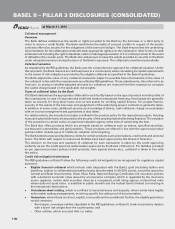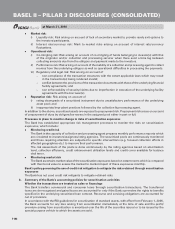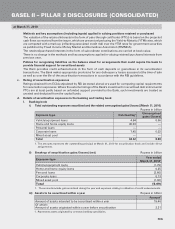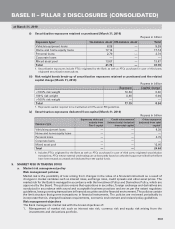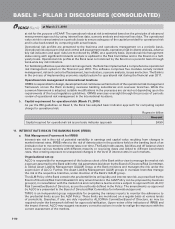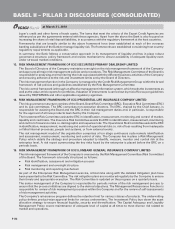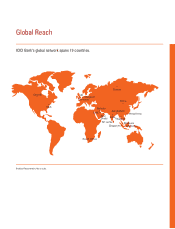ICICI Bank 2010 Annual Report Download - page 190
Download and view the complete annual report
Please find page 190 of the 2010 ICICI Bank annual report below. You can navigate through the pages in the report by either clicking on the pages listed below, or by using the keyword search tool below to find specific information within the annual report.
F110
at risk for the purpose of ICAAP. The operational value at risk is estimated based on the principles of advanced
measurement approach by using internal loss data, scenario analysis and external loss data. The operational
value at risk is stress tested on a periodic basis to ensure adequacy of the capital provided for operational risk
and is also back-tested by comparing with actual losses.
Operational risk profiles are presented to the business and operations management on a periodic basis.
Operational risk exposures (risk and control self assessment results, operational risk incidents analysis, adverse
key risk indicators and open risks) are monitored by ORMC on a quarterly basis. Operational risk management
status along with significant incidents analysis is updated to the Risk Committee and to the Board on a half-
yearly basis. Operational risk profile at the Bank level is monitored by the Board on a periodic basis through
bank-wide key risk indicators.
For facilitating effective operational risk management, the Bank has implemented a comprehensive operational
risk management system in the financial year 2010. The software comprises five modules namely incident
management, risk and control self assessment, key indicators, scenario analysis, issues and action. The Bank is
in the process of implementing economic capital system for operational risk during the financial year 2011.
Operational risk management in international locations
ORMG is responsible for design, development and continuous enhancement of the operational risk management
framework across the Bank including overseas banking subsidiaries and overseas branches. While the
common framework is adopted, suitable modifications in the processes are carried out depending upon the
requirements of the local regulatory guidelines. ORMG exercises oversight through the process of periodic
review of operational risk management in the international locations.
b. Capital requirement for operational risk (March 31, 2010)
As per the RBI guidelines on Basel II, the Bank has adopted basic indicator approach for computing capital
charge for operational risk.
Rupees in billion
Amount
Capital required for operational risk as per basic indicator approach 24.59
11. INTEREST RATE RISK IN THE BANKING BOOK (IRRBB)
a. Risk Management Framework for IRRBB
Interest rate risk is the risk of potential variability in earnings and capital value resulting from changes in
market interest rates. IRRBB refers to the risk of deterioration in the positions held on the banking book of an
institution due to movement in interest rates over time. The Bank holds assets, liabilities and off balance sheet
items across various markets with different maturity or re-pricing dates and linked to different benchmark
rates, thus creating exposure to unexpected changes in the level of interest rates in such markets.
Organisational set-up
ALCO is responsible for management of the balance sheet of the Bank with a view to manage the market risk
exposure assumed by the Bank within the risk parameters laid down by the Board of Directors/Risk Committee.
A Global Asset Liability Management (GALM) Group at the Bank monitors and manages the risk under the
supervision of ALCO. Further, the Asset Liability Management (ALM) groups in overseas branches manage
the risk at the respective branches, under direction of the Bank’s GALM group.
The ALM Policy of the Bank contains the prudential limits on liquidity and interest rate risk, as prescribed by the
Board of Directors/Risk Committee/ALCO. Any amendments to the ALM Policy can be proposed by business
group(s), in consultation with the market risk and compliance teams and are subject to approval from ALCO/
Risk Committee/Board of Directors, as per the authority defined in the Policy. The amendments so approved
by ALCO are presented to the Board of Directors/Risk Committee for information/approval.
TMOG is an independent group responsible for preparing the various reports to monitor the adherence to
the prudential limits as per the ALM Policy. These limits are monitored on a regular basis at various levels
of periodicity. Breaches, if any, are duly reported to ALCO/Risk Committee/Board of Directors, as may be
required under the framework defined for approvals/ratification. Upon review of the indicators of IRRBB and
the impact thereof, ALCO may suggest necessary corrective actions in order to realign the exposure with the
current assessment of the markets.
BASEL II – PILLAR 3 DISCLOSURES (CONSOLIDATED)
at March 31, 2010




